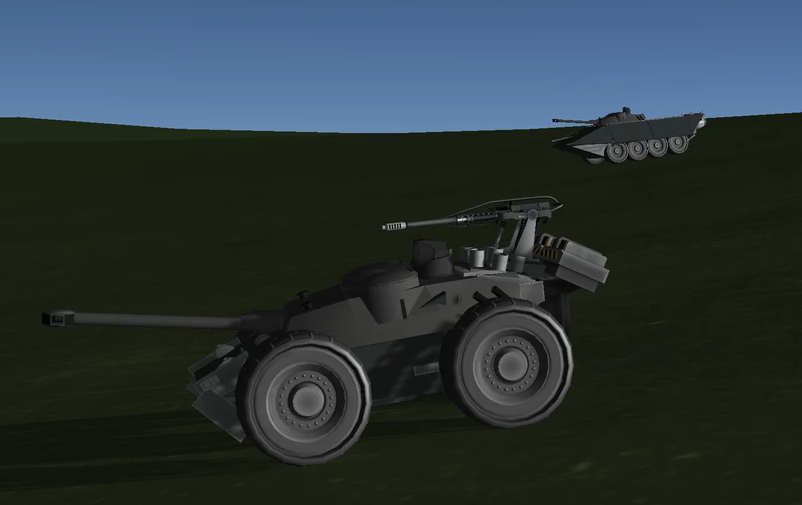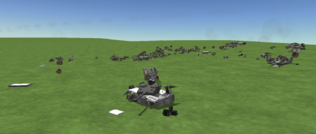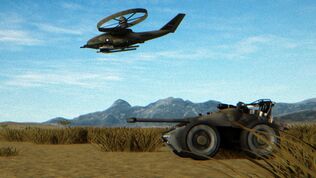ZHB HVHL "Honey Badger"
|
ZHB HVHL "Honey Badger"
|
|||||
|---|---|---|---|---|---|
| Light Attack Vehicle | |||||
 |
|||||
| National Origin | {{{origin}}} | ||||
| Production History | |||||
| Service History | |||||
| Used By | {{{operators}}} | ||||
The ZHB-HVHL, fully written "Zokesian Honey Badger - High Velocity, Heavy, Long-range," is arguably the most effective Light Attack Vehicle of the 2060s. The design has seen conflict across Kerbin and under many a flag, and multiple specialized versions of the Honey Badger exist and fill nitches into the 2070s.
Development
The development of the HVHL Honey Badger was begun in the early 2060s, following the success of the mechani built Badger in the Zoke-Sovie war. the design was small, fast, and featured an effective chain gun which could fight toe to toe with modern Main battle Tanks, despite being lighter armored. Casualty rates of Badgers were lower than main Battle Tanks and IFVs in the conflict, much to the surprise of the Armored Corps. With the knowledge that a small, fast vehicle could fight effectively against much larger threats, the Honey Badger design team set about first up-armoring existing Badgers and eventually stating from scratch on a new hull.
HVHL-A
The new design featured an angled bathtub which helped deflect shots from the front and side, and extra front armor to protect the electronics and ammo inside. An Eland-90 turret was chosen as main armament because of the cannon's offensive capability and turret's reliability in battle. An M230 Chain gun was added on top the rear deck to maintain high volume of fire at close range and as AAA armament.
Initial designs were built on the standard Balloon tyres of the Badger, but the increased weight was found to be too much for the wheels to handle and road-rated tires were added instead. To counteract the increased electricity draw at speed, a jet engine was added to the rear of the Badger to act as an alternator and take some of the pressure off the drive wheels.
The result was a vehicle comfortable travelling over 40 m/s without fear or rolling over. Such a platform proved to be a difficult target while still being able to fire back at enemy units at speed, even broadside. The capability to run circles around the enemy was in line with Zokesian doctrine of Infantry Fighting Vehicle mass assault, which were designed to rush enemy tanks and close range to knock them out. A supporting force of Honey Badgers would effectively cover the IFVs and distract tanks with a hard to kill target.
HVHL-B
In 2065 during the Delras Civil War, the need for an effective technical killing vehicle was made apparent in the numbers of small lightly armored vehicles seen in battle. The response was to tear the Eland-90 turret off HVHL-As and replace it with an armored cab housing first two, and later (on third generation HVHL-Bs) three M230 Chain Guns. The huge volume of fire capable of these weapons made the B model Armored Car a highly capable vehicle in support of the IFVs and Armor of the main Zokesian Army. The speed and firepower meant that closing to point-blank and unloading a salvo of 30mm explosive bullets was a highly effective, albeit dangerous tactic.
HVHL-D
The D model HVHL was designed in early 2068 by Ward Industries following an Ordinance request for a craft which could be used as indirect support for tanks. Ordinance wanted a vehicle capable of a first salvo from behind the lines, to take out a few enemy vehicles and turn the tide of the battle in the first few moments. The HVHL-D fit that role with a hull mounted ground attack radar system and four AIM-120 AMRAAM missiles set to ground attack mode. The weapon was promising in testing but was overshadowed by the CMB which promised the same effectiveness at half the cost and at four times the distance from the battlefield. In the end, 40 were ordered by the Zokesian Army and were later sold to Dust Harvest, where they fought in the First Dust War with limited success.
HVHL-A/B Mk III
The Mk III Badgers rolled out in 2076 to replace older Mk II Badgers, increasing armor while removing the jet power which propelled them. These models met mixed success, coming under stiff resistance in the Southern Polar Campaign of 2078-79. Unable to match the performance expected, they were used as a basis to create a new, improved Badger.
HVHL-A/B Mk V
The designers modified the Mk III Badger at great length before abandoning its chassis, completely rebuilding it with the new improvements on a stronger square body. This allowed the design to feature two crew, an additional rocket launcher on the back, and more ammunition for the 30mm gun. The design is being put into service as Mk IIIs are sold off or scrapped. The transition will complete by the end of 2079, with 183 of the -A and -B models in production.
Gen 4 Badger
Conflict
In the Dust Harvest conflict the HVHL-A and B models proved their worth fighting technicals along side the IFVs of Zokesian Light Infantry units. In the airborne role the A and B models again proved capable of airdrop from Duck II transports and were quickly made the backbone of the Zokesian Airborne. The Battle of Hill 122 distinguished the HVHL as it fought an enemy vastly outnumbering it and came out victorious. The First Dust Harvest Conflict saw the use of all three variants by Dust Harvest forces against Spice Reciprocity vehicles with huge success.
"It is obvious, seeing the numbers, that we will not win this war."
-Untes Kerman, President of Rostrum and last Leader of the Spice Reciprocity
On all fronts it is present the Honey Badger has been the bane of its enemies. Enjoying well over a 4:1 kill rate, even outnumbered the Badger fights longer than some battle tanks due to its speed, size and weaponry. Its pilots are brave and rush headfirst into battle, in front of the heavier armor, to take the fight to the enemy. Badger crews are some of the most revered personnel in the Zokesian Light Infantry because of how big an impact their little vehicles can make on the course of battle.
Foreign Users
Currently over a dozen foreign powers have used or currently still use the Honey Badger, as the craft continues to operate and excel in the new decade. The low price and high value of the craft mean surplus HVHLs are often sought after in world markets.
HVHLs are licence produced in numerous foreign nations, including Cloweish, Amber, Aenia, and Halco.

